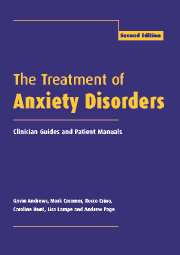Book contents
- Frontmatter
- Contents
- List of authors
- Preface to the second edition
- Abbreviations
- 1 Read me
- 2 General issues in anxiety disorders
- 3 General issues in treatment: Clinician Guide
- 4 Panic disorder and agoraphobia: Syndrome
- 5 Panic disorder and agoraphobia: Treatment
- 6 Panic disorder and agoraphobia: Clinician Guide
- 7 Panic disorder and agoraphobia: Patient Treatment Manual
- 8 Social phobia: Syndrome
- 9 Social phobia: Treatment
- 10 Social phobia: Clinician Guide
- 11 Social phobia: Patient Treatment Manual
- 12 Specific phobias: Syndrome
- 13 Specific phobias: Treatment
- 14 Specific phobias: Clinician Guide
- 15 Specific phobias: Patient Treatment Manual
- 16 Obsessive-compulsive disorder: Syndrome
- 17 Obsessive-compulsive disorder: Treatment
- 18 Obsessive-compulsive disorder: Clinician Guide
- 19 Obsessive-compulsive disorder: Patient Treatment Manual
- 20 Generalized anxiety disorder: Syndrome
- 21 Generalized anxiety disorder: Treatment
- 22 Generalized anxiety disorder: Clinician Guide
- 23 Generalized anxiety disorder: Patient Treatment Manual
- 24 Posttraumatic stress disorder: Syndrome
- 25 Posttraumatic stress disorder: Treatment
- 26 Posttraumatic stress disorder: Clinician Guide
- 27 Posttraumatic stress disorder: Patient Treatment Manual
- 28 Conclusions
- References
- Index
16 - Obsessive-compulsive disorder: Syndrome
Published online by Cambridge University Press: 05 August 2016
- Frontmatter
- Contents
- List of authors
- Preface to the second edition
- Abbreviations
- 1 Read me
- 2 General issues in anxiety disorders
- 3 General issues in treatment: Clinician Guide
- 4 Panic disorder and agoraphobia: Syndrome
- 5 Panic disorder and agoraphobia: Treatment
- 6 Panic disorder and agoraphobia: Clinician Guide
- 7 Panic disorder and agoraphobia: Patient Treatment Manual
- 8 Social phobia: Syndrome
- 9 Social phobia: Treatment
- 10 Social phobia: Clinician Guide
- 11 Social phobia: Patient Treatment Manual
- 12 Specific phobias: Syndrome
- 13 Specific phobias: Treatment
- 14 Specific phobias: Clinician Guide
- 15 Specific phobias: Patient Treatment Manual
- 16 Obsessive-compulsive disorder: Syndrome
- 17 Obsessive-compulsive disorder: Treatment
- 18 Obsessive-compulsive disorder: Clinician Guide
- 19 Obsessive-compulsive disorder: Patient Treatment Manual
- 20 Generalized anxiety disorder: Syndrome
- 21 Generalized anxiety disorder: Treatment
- 22 Generalized anxiety disorder: Clinician Guide
- 23 Generalized anxiety disorder: Patient Treatment Manual
- 24 Posttraumatic stress disorder: Syndrome
- 25 Posttraumatic stress disorder: Treatment
- 26 Posttraumatic stress disorder: Clinician Guide
- 27 Posttraumatic stress disorder: Patient Treatment Manual
- 28 Conclusions
- References
- Index
Summary
Obsessive-compulsive disorder (OCD) was considered a relatively rare syndrome with a reputation for being a chronic, incapacitating, and intractable condition. Epidemiological studies have suggested that OCD is considerably more prevalent than was previously thought, with lifetime estimates ranging between 2% and 3%. More recent studies that have reassessed the diagnosed cases of OCD in epidemiological studies have suggested that the true rate of OCD may be somewhat less, with 1 month prevalence rates of 0.6% (Stein et al., 1997). Similar prevalence rates (0.7%) have been reported in a recent Australian Survey of National Mental Health and fiell-being (Andrews et al., 2001a). The intractability of the disorder has been called into question, with the development of effective psychological and pharmacological interventions that mean that the majority of sufferers can be assisted in controlling their disabling symptoms. The following sections review the current state of knowledge regarding OCD and its treatment. Rather than attempt to be exhaustive in the areas covered, the aim has been to supply the practicing clinician with information that will be of use within clinical practice, particularly in terms of questions often asked by sufferers and significant others, as well as treatment issues and factors that may affect outcome.
Diagnosticc riteria
Obsessions are defined as ideas, thoughts, images and impulses that enter the subject's mind repeatedly. They are recognized as a product of the subject's own mind, are perceived as intrusive and senseless, and efforts are made to resist, ignore or suppress such thoughts. Compulsions are repetitive or stereotyped behaviors that are performed in response to an obsession in order to prevent the occurrence of an unlikely event or to prevent discomfort. Resistance is often evident, but may be minimal in longstanding cases. The diagnosis of OCD is to be made if the individual experiences both obsessions and compulsions, obsessions alone or compulsions alone, given that such symptoms are time consuming or significantly interfere with the person's functioning. A comparison of ICD-10 and DSM-IV diagnostic criteria shows considerable agreement.
CASE VIGNETTE
Patient identification
Mr. P is a 30 year old father of two children who presents with a 9-year history of compulsive behavior. At the time of presentation, he was engaging in extensive checking behavior that significantly interfered with his life.
- Type
- Chapter
- Information
- The Treatment of Anxiety DisordersClinician Guides and Patient Manuals, pp. 332 - 345Publisher: Cambridge University PressPrint publication year: 2002

